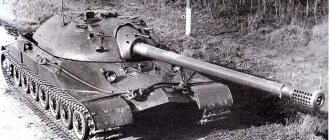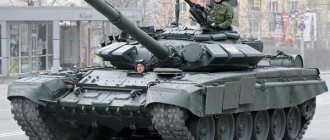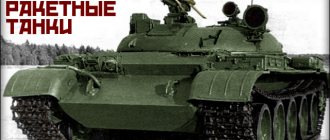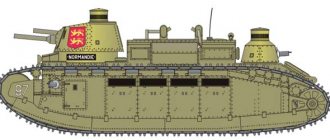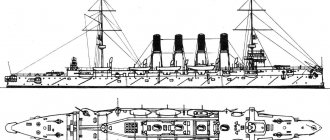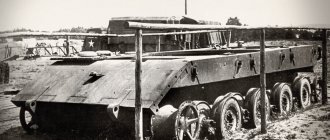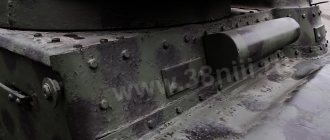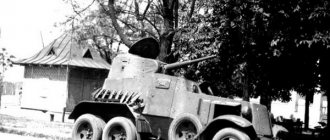The history of the appearance of the T-34-57 tank
Production of this model began in 1941, after the need arose to improve the combat capabilities of the KV-1 and T-34. The main problem of the old models was the weak 76 mm gun, so it was decided to introduce a 55-60 mm gun into the new model. At the same time, OKB No. 92 was already developing a 57-mm high-power anti-tank gun, after which they also released a preliminary design for the T-34. The first prototype was released in September 1941.
Until 1940, the development of a new modification of the tank proceeded extremely slowly due to the plant being busy with the production of the 76-mm F-34 tank gun. The first tests began at the end of 1940, in early December. Factory tests of the gun took place until March 1941, after which in April it was installed in the T-34 turret, instead of the originally planned F-34. However, when the tank entered testing at ANIOP, the gun showed low survivability, namely, the barrel was noticed to be open after firing 100-150 rounds. In addition, the accuracy of fire was insufficient - 2 times lower at a distance of 1 km than that of a 76 mm gun.
Still, in the end, the T-34 tank with a 57-mm cannon (ZIS-4) was stronger than enemy tanks, so a decision was made to correct the defects and subsequent serial production. After modification, tests were carried out at the Sofrinsky training ground, which showed satisfactory results in terms of combat accuracy and hitting targets even at a distance of more than 2 km.
Production of the ZIS-4 was suspended in December 1941 due to production difficulties and a lack of ammunition. In total, 133 57 mm tank guns were fired . To arm production tanks before the evacuation, KhPZ received 21 units. ZIS-4, another 20 guns went to STZ. Starting from October 1, 1941, the production of fighter tanks with a production plan of 100 units. he was supposed to be working on it by the end of the year, but this product was not found in his reports.
At the beginning of 1942, after the production of the ZIS-4 was frozen, OKB No. 92 began producing a new 57-mm gun called IS-1, which replaced the old one. The ZIS-4 was remembered in 1943, since at that time 57-mm guns were the only artillery systems that could effectively resist the German heavy tanks “Panther” and “Tiger”.
Anti-tank gun ZIS-2 and its tank version
The experience of the Soviet-Finnish and the initial period of the Second World War showed that the future belongs to tanks with anti-ballistic armor, which can be effectively used both in tank battles and in breaking through enemy defenses. In the Soviet Union, it was assumed that leading countries would soon receive tanks with powerful armor protection, which would require more powerful artillery systems to combat. In July 1940, at the design bureau at plant No. 92 in Gorky, under the leadership of Vasily Grabin, a new 57-mm anti-tank gun ZIS-2 was created. At the same time, Grabin’s design bureau, on its own initiative, developed a design for a tank gun based on the ZIS-2. This weapon, intended for arming T-34 tanks, received the designation ZIS-4.
Designer V. G. Grabin (1900−1980). Source: warheroes.ru
During testing, this gun showed excellent results for its time. From a distance of 1000 meters, the ZIS-4 penetrated 70 mm. armor and was capable of hitting any tanks that existed at that time. It was noted that at a distance of 800 meters, this gun can fight armored vehicles with armor up to 80 mm. Initially, it was planned to equip the T-34M tank with 57-mm ZIS-4 tank guns. But with the beginning of the Great Patriotic War, work on the creation of this machine was curtailed. Certain difficulties also arose during the production of the ZIS-4 tank gun itself, since priority was given to the production of the complex, highly skilled ZIS-2 anti-tank gun.
Achievements T 34 57
At the beginning of October 1941, 10 vehicles with a 57-mm gun became part of the 21st tank brigade in Vladimir, which arrived at the front on October 14. The brigade was given the task of attacking in the direction of Turchinovo and Pushkino. The purpose of the campaign was to strike the flank of a group of German troops. The fighting lasted 4 days and during these days 34 fascist tanks, 25 anti-tank guns, and 210 vehicles were destroyed. There were also losses on our side - the commander of the tank regiment of the brigade, V. Lukin, and the battalion commander, Mikhail Agibalov, died.
Another example of the successful use of T-34 57 fighter tanks is a raid on German rear lines under the command of senior political instructor Gmyr. Then he almost point-blank shot a convoy of German cars with soldiers on the Volokolamsk highway, after which he moved further and, driving to the German airfield, completely destroyed their bomber with the help of the T 34 57.
At the moment, not a single T-34 57 officially remains, however, there is information that one version was preserved in Nizhny Tagil, another at the “Battle Glory of the Urals” site in Verkhnyaya Pyshma, and one copy was recreated from the wreckage in the Moscow region, in Pushkino.
Video about T-34 57
Battlefield. T-34-57 - a rare tank that saved Stalin and could fight the Tigers (4 photos)
Author: Evgeny
November 30, 2016 10:16
Tags: USSR auto war history facts
12349
4
Battlefield. T-34-57 - a rare tank that saved Stalin and could fight the Tigers
0
0
×
0
0
It is generally accepted that the main guns for the T-34 were 76 mm in the first period of the war and 85 mm in the second. However, in the metal there was a modification of the thirty-four, armed with a 57-mm cannon, which could easily fight any Wehrmacht tanks. The history of this tank began after the winter campaign in Finland, the bitter lessons of which forced the leadership of the Red Army to think about reforming the army, in particular, about the armament of tanks, which had previously been considered sufficient. The work was prompted by intelligence information about the development of heavily armored tanks in Germany, received by the Soviet military leadership in the spring of 1940. At this time, the development of a new 57-mm anti-tank gun with a high initial projectile velocity was carried out by design bureau No. 92 under the direction of the talented Soviet designer Vasily Grabin. Therefore, the design bureau was instructed to create a similar weapon that would fit into the T-34 turret without significant modifications to the latter. The first pancake is lumpy. A prototype of the gun was manufactured only in September 1940. This was followed by tests on a field carriage, which lasted until the end of March 1941. And only in April did it come to installing a gun in the T-34 turret to replace the 76-mm F-34 gun. The first tests did not show the best results: after 100-150 shots, the gun barrel overheated greatly, and the accuracy of fire at a distance of 1000 m was 2-2.5 times lower than that of a 76.2 mm gun. To achieve positive results, the designers had to change the steepness of the cutting, add a phlegmatizer and make other design changes. After modifications, the gun performed well at the Sofrinsky tank training ground, where firing was carried out on July 6th. During tests, the 57-mm gun confidently hit targets at a distance of up to 2000 m, and in terms of armor penetration it significantly surpassed the 76.2-mm gun: distance of 500 meters - 98 mm armor plate (90° angle) and 83 mm armor plate (60° angle) distance 1000 meters - 90 mm armor plate (angle 90°) and 78 mm armor plate (angle 60°); distance 1500 meters - 82 mm armor plate (angle 90°) and 73 mm armor plate (angle 60°). To simplify production, the 57-mm ZIS-4 gun was unified with the 76.2-mm F-34 gun, from which the new product differed in its longer barrel length and breech wedge. To balance the ZIS-4, special counterweights weighing 180 kg were added. Unnecessary tank destroyer The war made its own adjustments to the production of ZIS-4 tank guns, and production difficulties were added (factories were evacuated), so by December 1, 1941, production of 57-mm guns was discontinued. As a result, only 21 tank guns were sent to KhPZ before the evacuation and 20 went to STZ. Also, the production of fighter tanks, as the T-34 with a 57-mm gun was dubbed by the military, was supposed to be produced. The plan for the enterprise was 100 tanks per month, but these vehicles were not found in its reports. How many T-34−57s were produced is still unknown, however, reports from the fronts mention these tanks. For example, 10 such vehicles fought as part of the 21st Tank Brigade, which arrived at the front on October 14. During an attack on the flank of the German group in the Kalinin area, the crews of the thirty-four destroyed 34 German tanks, 25 anti-tank guns and 210 vehicles. But by November 25, all the “fighter tanks” in the brigade were lost; the commander of the tank regiment of the Hero of the Soviet Union brigade, Major Lukin, and the commander of the 1st battalion, Hero of the Soviet Union, Captain Agibalov, were killed in battle. It is also known that eight T-34−57 tanks entered the 8th Tank Brigade of the Kalinin Front on October 19, 1941. The production of the T-34−57 was discontinued in 1941, one of the main reasons was the excessive power of the guns. 57-mm cannon shells penetrated the armor of any German tank, and the high-explosive effect of the ZIS-4 shell was insufficient to combat infantry and anti-tank artillery. Reports came from the fronts that sometimes 57-mm shells penetrated through light German and Czech tanks without causing them significant harm. Only during the Battle of Kursk the guns began to fight again due to the fact that the heavy German tank PzKpfw VI, known as the “Tiger,” appeared at the front. In principle, it was possible to knock it out using a conventional 76-mm F-34 tank gun, but it was too difficult to fight this tank. To destroy the Tigers, it was necessary to approach a distance of up to 200 meters and fire at the sides or stern of the enemy, using sub-caliber ammunition. Usually it took 5-6 hits on the side to disable the Tiger; the lower armor plate was hit by a sub-caliber projectile at a distance of up to 50 meters, which made it practically invulnerable in a frontal duel. Losses from medium Soviet T-34s in collisions with heavy Tigers were very large, although this was not customary to advertise. An indicative example is the battle near Oktyabrsky, in which about 30 T-34s and 10 KV-1s were sent to surround, knock out, and, if possible, capture new German tanks, which the German leadership, on the hasty orders of Hitler thrown into battle. The Fuhrer was dissuaded from this by many generals, considering the risk “unjustified,” because the “Tigers” were supposed to become a “surprise for the Russians” in the upcoming Operation Citadel. According to some reports, in this confrontation between the Soviet tank group and the German tank brigade (three Tiger tanks, 2 StuG assault mounts and two armored personnel carriers), our losses amounted to 16 medium T-34 tanks and 4 heavy KV-1 tanks, which speaks to the enormous technical superiority of the Tigers in firepower and armor, especially considering that they fought in flanking conditions. The tank that saved Stalin There is a version according to which the T-34−57, commanded by the famous tank ace Dmitry Lavrinenko, saved Stalin’s life. This happened during the visit of the Secretary General to the 16th Army of General Rokossovsky, which held the defense in the Volokolamsk direction. In particular, Stalin wanted to see the work of the famous Guards Katyusha mortars. On the way back, Stalin's Packard got stuck in the virgin snow, and he had to transfer to an Emka, which also soon stopped. At this time, Dmitry Lavrinenko’s tank platoon came to the rescue, and just in time, a German SS cavalry division approached the area from which the Katyushas were firing. The Germans could have easily captured two cars with guards, but the appearance of three tanks noticeably cooled their ardor. Stalin was able to return safely to the headquarters of the 16th Army. By the way, Dmitry Lavrinenko is considered one of the most effective tank crews of the USSR: in a total of 2.5 months of fighting, he was able to knock out 52 enemy tanks, most of which he destroyed with the T-34−57. The brave tankman died on December 7, 1941 - he was struck by a mine fragment during artillery shelling. Didn’t meet with the “Tigers” and “Panthers” The command remembered the T-34−57 tanks with the appearance of the Pz. Kpfw V Panther and Pz. VI Tiger. Especially for the T-34 and KV, a new 57-mm ZIS-4M gun was developed, which featured a bolt unified with the F-34, a simplified semi-automatic mechanism and a modified fastening of the coupling in the cradle. The ZIS-4M's aiming angles ranged from -2 to +31 degrees, and the height of the firing line was 2110 mm. Also, a new armor-piercing projectile of increased power was developed for the gun with an initial speed of 1000 m/s according to the passport, but in fact - 1010 m/s. The projectile, which weighed 3.44 kg, penetrated an armor plate 106 mm thick at a distance of 500 meters, and a 96 mm sheet at a distance of 1000 meters. It quickly became clear that such shells greatly reduced the life of the gun; in addition, cases of barrel swelling were noted. Therefore, the entire batch - 2800 pieces - was withdrawn from circulation. The T-34−57s that arrived at the front in August 1943 were united into the “special tank company 100.” Testing of these vehicles took place from August 15 to September 5, 1943, but during all this time they did not have the chance to take part in battle with the German “menagerie”. During the entire time that the company was in the army, the unit that was assigned to the “special company 100” met with German tanks only once, and the “fighter tanks” were in reserve at that moment. As a result, firing was carried out at abandoned German armored vehicles and bunkers. Based on the results of the shooting, the company commander, Captain Volosatov, and the representative of the GABTU, engineer-colonel Zaitsev, highly appreciated the capabilities of the ZIS-4M gun. The only serious drawback of the 57-mm gun was the extremely poor quality of fragmentation shells, which produced incomplete explosions or even did not detonate at all. Further traces of T-34−57 tanks were lost. It is known that 172 ZIS-4M guns were produced during 1943, and according to a 1944 report, 19 more were shipped, probably to repair damaged tanks. The final interest in the T-34−57 faded in 1944, due to the transition to a more effective 85-mm gun. To this day, the location of not a single copy of this rare tank is reliably known. According to some sources, one T-34−57 is located somewhere in Nizhny Tagil.
Source:
More cool stories!
- When a date didn't go according to plan: stories from the Internet
- Magnificent seven facts about everything in the world
- An 11-year-old man was bedridden and cured himself
- The job of a car mechanic is full of surprises.
- Finds from the La Pomoika boutique
Tags: USSR auto war history facts
Do you like to remember how things were before? Join us, let's feel nostalgic together:
70 23 47
Liked
47 4
48
Partner news
Technical characteristics TTX T-34 57
| Weight | 26000 kg |
| Crew, people | 4 |
| Dimensions | |
| Length, mm | 5920 |
| Width, mm | 3000 |
| Height, mm | 2400 |
| Ground clearance, mm | 400 |
| Armament | one 57 mm ZIS-4 or ZIS-4M anti-tank gun and two 7.62 mm DT machine guns |
| Ammunition | |
| Aiming devices | telescopic sight TMFD-41periscope PT 4-14commander panorama PTK-5 |
| Booking | hull front – 45 mm hull side – 40-45 mm hull rear – 40-42 mm turret front – 45 mm turret side – 45 mm turret rear – 45 mm gun mask – 40 mm roof – 16-20 mm bottom – 13-16 mm |
| Engine | V-2-34, diesel, 500 hp. |
| Transmission | mechanical type |
| Chassis | (on one side) 5 double rubber-coated road wheels per side, rear drive and front idler wheels, large-link caterpillar made of steel tracks |
| Speed | 54 mph on the highway25 mph on a country road |
| Power reserve | 300 km on the highway230 km on the country road |
| Obstacles to be overcome | |
| Elevation angle, degrees. | 36° |
| Wall height, m | 0,75 |
| Fording depth, m | 1,30 |
| Ditch width, m | 3,40 |
| Means of communication | radio station 71TK-3 |
Video about the T-34 57 tank
Since the start of operation of the T-34 medium tank, Soviet designers have been looking for ways to increase its firepower. Already in 1941, the L-11 cannon was replaced by the more advanced F-34. Before the start of production of the T-34-85, the basis of the tank fleet was made up of vehicles with a 76-mm gun. But there was also a lesser-known version of the tank with a 57 mm cannon. T-34\57, or T-34 “Fighter”, which had very outstanding characteristics. We'll talk about it today.T-34\76 model 1940 had a 76-mm L-11 cannon (later F-34). Based on them, a tank with a new gun was created.
Hole-punch gun In 1940, the USSR army leadership recognized the ineffectiveness of the 45-mm 20-K anti-tank guns. Plant number 92 was tasked with developing a replacement, with a caliber of 55-60 millimeters, which was predicted to become the main anti-tank gun.
Anti-tank gun ZiS-2 on the streets of Berlin, 1945. This weapon formed the basis for the ZiS-4 tank gun
Before the start of the war, in the spring of 1941, tests began on the 57-mm ZIS-4 cannon. The tank gun, created under the leadership of Vasily Gavriilovich Grabin, was based on the ZIS-2 field gun and had similar characteristics. Thus, the BR-271 armor-piercing projectile could hit a 74-mm inclined (60 degrees) armor plate from a distance of a kilometer.
The first samples of the ZiS-4 gun were a barrel from the ZiS-2, combined with the breech of the F-34 gun
The gun itself was an F-34 tank gun, the barrel of which was replaced with a 57-mm ZiS-2 gun barrel. To compensate for the mass of the longer gun, counterweights were installed on its cradle. The gun, in general, satisfied the commission, but it was recommended to modify it. The life of the gun did not exceed 100 shots, and the quality of the rifling in the barrel led to low accuracy.
The tank with a 57 mm cannon received a new sight and gun mantlet. Otherwise, the vehicle corresponded to the linear T-34-76
In July of the same year, the gun was brought to the desired condition, and then its production began. The gun was recommended for installation on the modernized T-34, whose firepower increased significantly. So a new modification of the “thirty-four” was adopted. To release or not to release? Until September, only 10 tanks with the new gun were assembled, and by the end of the year, production of the ZiS-4 was stopped. In the documents, the tank was simply designated “T-34 with a ZiS-4 gun.” After the war, a number of unofficial names stuck to the car: “Fighter” and “T-34\57”.
T-34 with a ZiS-4 gun during testing. After eliminating “childhood diseases”, production of tanks with a 57-mm gun began in July 1941
The meager scale of production was due to a number of factors. There was a shortage of armor-piercing 57-mm shells in the army. In addition, testing the production of a new model would mean a break in tank production, and at that time this was not possible. From June to September 1941, the losses of the USSR reached critical proportions, and by October a situation arose when the number of Soviet tanks was inferior to the number of enemy vehicles (by the way, for the first and last time).
Despite the satisfactory results demonstrated by the new tank, the production batch was limited to 10 vehicles
The forgotten gun was “remembered” in 1943, when Germany’s new heavy tanks posed new challenges for Soviet designers. Production was restored in the spring. Using components produced in 1941, five guns were quickly delivered, four of which were installed on the T-34. Now the base for the gun was a new model of the "thirty-four" with a hexagonal turret - a "nut".
The tank was remembered in 1943, when short-barreled 76-mm guns showed low effectiveness in the fight against German Tigers and Panthers.
After field tests, three vehicles, part of the special tank company 100, went to the front in August 1943.
T-34-57 undergoing field testing. Work on 57-mm tank guns was stopped, shifting the emphasis to equipping the T-34 with 85-mm guns
The test results were summed up on September 5 of the same year, and the gun was again given the go-ahead. Plant No. 92 produced an initial batch (170 pieces) of guns in a slightly modernized version - ZiS-4M. But in less than a month everything changed! Successes in the development of 85-mm guns inspired the military, and the good, but “superfluous” ZiS-4M gun was abandoned.
The 57mm T-34 model of 1943 received a characteristic hexagonal turret
The basic prototype of the 57-mm T-34 was a standard tank produced by Kharkov plant No. 183. It was distinguished by a welded turret and an "early" type driver's hatch. The new gun received a TMFD sight - instead of the standard TOP. Otherwise, the T-34s with the ZiS-4 gun were similar to the linear “twenty-fours”.
"Fighter" on the hunt
The first ten T-34s with a 57 mm gun were transferred to the 21st Tank Brigade, stationed on the Kalinin Front. According to reports, between November 15 and 16, 18 German tanks were destroyed by 57 mm cannon fire.
"White Twenty" by Major Lukin
More notable is the fight on October 14th. Then the tanks of the 21st brigade, stationed at the Demidovsky station, went on the offensive on the Turchinovo-Pushkino-Troyanovo line. It was planned to strike the German flanks in the Kalinin area (present-day Tver).
In the autumn battles of 1941, the tanks of the 21-1 brigade showed high efficiency. But the price was high: all T-34s with ZiS-4 guns were lost
The first contact with the enemy happened at a tank under the command of political instructor E. Gmuri. He went alone on reconnaissance along the Volokolamsk Highway, where he came across a convoy of German supply trucks. The column, three kilometers long, was destroyed on the march by a single tank. After this, Gmuri's tank moved to the airfield occupied by the Germans, where he managed to burn down a German bomber.
T-34-57, produced by plant No. 183, shot down in the fall of 1941
At that point, the history of the tank was interrupted: Gmuri’s tank was hit by German artillery. Moreover, two crew members died. And the political instructor, together with Sergeant Ivashchenko, managed to return to the army. Speaking about their exploits, it is unknown whether this was due to the tank with a 57 mm gun, since the brigade also had vehicles with a 76 mm gun.
T-34-76 with a hexagonal turret. Such tanks became the basis for the 57-mm ZiS-4M gun in 1943
The Soviet ace, junior lieutenant S.Kh. Gorobets, also fought as part of this unit, and seven enemy tanks were destroyed. And perhaps the most famous tank of this series was Lukin’s “White Twenty”, destroyed at Troyanovo.
T-34-57 model 1943 at the T-34 History Museum
By 23 October 1941, the 21st Brigade claimed the destruction of 1,000 German infantry, 34 tanks, 210 trucks and 31 guns. But it cost big losses – including those of the command staff. Thus, the brigade commander, Hero of the Soviet Union, Major M.A., was killed. Lukin and the commander of the 1st battalion, Captain M.P. Agibalov. Results Despite the excellent characteristics of the 57-mm cannon, the T-34s equipped with it had a difficult fate. A series of acceptances/refusals from operation prevented the tank from fully demonstrating its qualities. But, despite the fact that in the first battles near Moscow, all T-34s with ZiS-4 were destroyed, they were able to compare favorably with their counterparts with 76-mm guns.
Replica of the T-34-57 model 1941 in the “Combat Glory of the Urals” museum
Not a single original T-34-57 has survived to this day.
In the “Military Glory of the Urals” museum there is a car with a ZiS-4 gun, but this is a replica. It is based on a body from a T-34 produced by STZ with rollers from a Kharkov T-34 and a dummy barrel. A modification of 1943 can be seen at the T-34 tank museum. Comments (0) | Print | | Complaint
Source:
https://x-true.info/73950-t-34-57-sovetskij-tank-istrebitel.html

